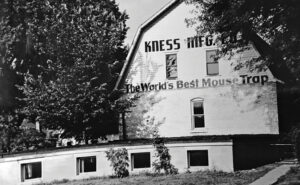
Austin Enos “Brick” Kness
In the professional pest control industry, few figures loom as large as Austin Enos “Brick” Kness. This innovative janitor-turned-inventor created a product that would transform the industry and establish a century-long legacy of pest management solutions.
Kness was born in Chadwick, Ill., in 1889, the second of eight children. During his childhood, the family moved around doing farm work, finally settling near Monticello, Iowa. After completing the eighth grade, 15-year-old Kness quit school, left home and headed West. He got by as a farmhand and even as a traveling professional wrestler.
In his early 20s, Kness worked in logging camps in Washington and Oregon, becoming a barber and cutting the hair of his fellow loggers. He also labored in orchards and dairy farms, and trained in Omaha, Neb., as an automotive repairman.
As a written family history recalls, the various places Kness worked inspired him to build tools to assist him in any tasks at hand. He built “a boat powered by a vehicle; a light bulb extractor for high ceilings; a one-wheel trailer; a rural mailbox; a garden hoe… a contour plow and harrow; a left-hand turn signaling device for an automobile, a lift box on the three-point hitch of a tractor” and many other innovations.
But by age 25, Kness was back at the family farm, settling down with his new bride, Bessie. They had three daughters and three sons, but Bessie died nine years later of influenza. Their baby was barely six weeks old, and their oldest child was 7.
To make matters worse, the farm was having a bad year in 1924 and Kness had to take a job to make ends meet. He was hired as a custodian at Audubon High School in Audubon, Iowa.
In this new position, Kness faced a persistent mouse problem. He was frustrated with the time and labor involved in setting numerous traps around the school, emptying all the full traps, cleaning up the mess and starting over again, day in and day out.
Kness fell back on his tinkering habit and engineered an ingenious device cobbled from everyday items: a square oil can, an empty Tuxedo Tobacco tin, a spring from a curtain rod and the wooden base of a crate. The first night he set his trap, he captured five mice. He was elated, as were the teachers, his friends and family. They encouraged him to take out a U.S. patent on the trap, which he was granted in 1930.
This trap could capture multiple rodents without needing to be reset — and was the first iteration of what became the Ketch-All Multiple Catch Mousetrap that is still in use today.

From 1944 to 1976, this converted barn in Albia, Iowa, housed Kness’ manufacturing headquarters. PHOTO: KNESS PEST DEFENSE
From humble beginnings to industry sensation
Kness’ invention quickly gained traction. In 1927, he formed the Kness Manufacturing Co. at Buena Vista College (now University) in Storm Lake, Iowa, to produce the Ketch-All trap and another profitable invention from his days working in orchards, the Roto-Bow tree saw. When the Great Depression hit in 1929, he had to close the doors on his dream and head back to Audubon to work odd jobs once again.

A.E. Kness, as he was known in newspaper articles of the time, shows off an early model of the Ketch-All Automatic Trap. PHOTO: KNESS PEST DEFENSE
For Kness, 1938 was a good year. Not only did he find love again with his second wife, Lola, he began to build a few more mousetraps with machinery and materials salvaged from his former business. This time around, he had salesmen who were so good, they were placing orders faster than he could fill them. In 1942, his three sons invested in the business to help bolster the funds needed to secure labor and materials to keep pace with sales. In 1944, Kness relocated the company to Albia, Iowa, in a converted barn that served as the manufacturing headquarters until two years after Kness died in 1974.
All three sons — Lester, Mike and Arnold — served in World War II and returned home to help their father with the business. Kness was able to slow down and tend to his first love, his farm.
There were ups and downs, and times when they took on projects like flipping old houses to keep the cash flowing. But unlike the early 1930s, the Kness Manufacturing Co. could continuously sell and market the Ketch-All traps, among other products.
A turning point
The real breakthrough for the Ketch-All traps came with the establishment of certain regulations by the Occupational Safety and Health Administration (OSHA) shortly after its formation in 1971. Food processing companies were mandated to use box traps to reduce airborne rodent hair particles, among other contaminants. Suddenly, the Ketch-All was a go-to solution for pest control companies servicing these facilities. This regulatory shift catapulted Kness’ modest company into a thriving enterprise.
Today, Kness Pest Defense continues to produce approximately 100,000 Ketch-All traps annually. Kness’ granddaughter, Kathy Wauseon, remains chair of the company, and several family members hold board positions. The company’s product line has expanded, but the core principles of innovation and effectiveness established by Brick Kness remain at its heart.
Leave A Comment